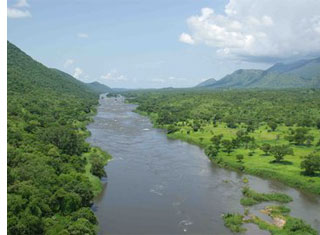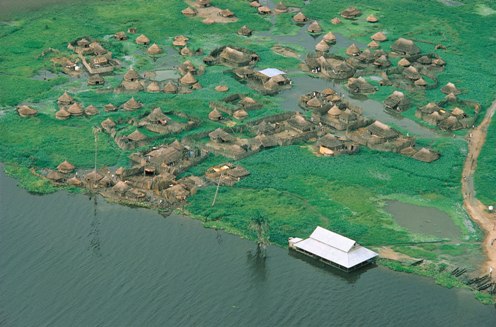|
|
|
Editor's Comment: The Republic of South Sudan became an independent state and the world's newest country in July, 2011. But just how "independent" it is or will remain is questionable. Northern and Southern Sudan ended a 22 year civil war in 2005. USAID has been pouring money into the South since 2005 and Sudan, North & South combined have an external debt of about $34 billion. South Sudan is rich in petroleum, water and agricultural lands with about 80% of Sudanese oil deposits in the South. The predators are now stalking the riches of one of the poorest and weakest peoples in Africa. -LMB |
|
|
|
|
|
|
The Nile River is the life blood of South Sudan |
|
|
|
A South Sudan village along the Nile |
South Sudan: Another Kitchen-Garden?
Its was expected; nevertheless, the announcement that agricultural development will be among the top cooperation priorities between Israel and South Sudan has raised fresh, deep fears in Cairo and Khartoum that intensive farming techniques and dams construction will end up depriving Sudan and Egypt from a vital portion of their Nile water sharing already scarce quotas.
During the first official visit to Juba after South Sudan’s independence on July 9th, an Israeli delegation chaired by the Knesset deputy speaker Danny Danon met with South Sudan’s minister of Presidential Affairs and Foreign Minister in charge Deng Alor, who confirmed on August 29th the soon exchange of ambassadors between the two countries.
South Sudan’s high official said that cooperation between his country and Israel will comprise agricultural development, as well oil, mining, roads, and bridges. The Israeli delegation, which also met South Sudan’s president Salva Kiir, said that Israel will cooperate with South Sudan in the areas of agriculture, science and technology.
Reacting to South Sudan’s decision to established diplomatic ties with Israel, Rabii Abdul Atti, of Sudanese ruling National Congress Party, warned on August 29th that such a decision constitutes a “threat to the Arabs and the entire region.”
Why Worry?
In declarations to Quds Press agency, he blamed Arab and Muslims countries for “undermining” what he called “the Israeli threat” in southern Sudan. At the moment of drafting this report, Egypt had not reacted to the Israel and South decision on August 28th to establish diplomatic relations.
Abdul Atti did not refer explicitly to two key sources of concern raising from the announced close cooperation between Tel Aviv and Juba—water and oil, let alone an old U.S. project to set an “ally” bock in the East of Africa, with oil and water rich South Sudan at its core.
The Nile Water Sharing Conflict
In 1929 Egypt and Britain agreed that no Nile basin state would ever decide any irrigation or hydro projects, construction of dams, or any other action what-so-ever on the Nile course, branches and lakes that would decrease the amount of water reaching Egypt, without prior agreement with the Egyptian government.
Later on, a new treaty reached in November 1959, allocated 55.5 billion cubic meters a year of Nile waters to Egypt and 18.5 billion for Sudan.
Israeli Delegations Touring the Nile Basin Countries
Over the last two years, an increasing number of Nile Basin riparian countries (ten in total) started questioning the historic water sharing agreement, alleging need to build dams to generate power and above all intensive, high water consuming farming projects.
This consolidated trend coincided with Israeli delegations touring the Nile Basin countries, offering technical support and modern technologies to develop the agricultural sector in those countries. Ethiopia has been among the key supporters of the Israeli proposals.
Both Sudan and Egypt have strongly rejected any modification to the 1959 treaty. Khartoum and in particular Cairo underlined the fact that their respective populations have highly increased over the last half a century, and that they need more Nile waters instead of decreasing their share.
The Oil Conflict
Southern Sudan’s oil production accounts 80-85% of all Sudanese oil output before Juba’s independence from Sudan on July 9th this year.
According to the 2005 Comprehensive Peace Agreement (CPA), the oil revenues are to be split equally between the now two countries. These revenues constitute more than 98% of Southern Sudan’s budget.
Foreign Corporations At Work
More oil and other mineral resources can be found throughout Southern Sudan, but the Bentiu region is commonly known as being especially rich in oil, while the Jonglei, Warap and Lakes states have potential reserves.
In recent years, a significant amount of foreign-based oil drilling has begun in Southern Sudan, raising the land’s geopolitical profile.
The Sudanese government in Khartoum has partitioned much of the once unified Sudan into blocks, with about 85% of the oil coming from the South.
These blocks are mainly operated and controlled byy the largest overseas consortium, the Greater Nile Petroleum Operating Company (GNPOC), which is composed of China National Petroleum Corporation with a 40% stake; Petronas (Malaysia) with 30%; Oil and Natural Gas Corporation (India) with 25%; and Sudapet of the central Sudan government with 5%.
Other producing blocks in South Sudan are blocks 3 and 7 in Eastern Upper Nile, which are controlled by Petrodar which is 41% owned by CNPC, 40% by Petronas, 8% by Sudapet, 6% by Sinopec Corp and 5% by Al Thani.
Another major block in South Sudan, called Block B by Khartoum, is claimed by several players. Total of France was awarded the concession for the 90,000 square kilometre block in the 1980s but has since done limited work invoking “force majeure”.
The Israeli-South-Sudanese close cooperation is feared to impact both the oil revenue sharing agreement with Sudan and the construction in the new state of pipelines that would severally affect Sudan’s share and exploitation activities.
Some Fact About This Big, Very Poor Country
South Sudan extends over 700 sq. kms., over one fourth of Sudan’s total surface of 2,5 million sq.kms.
Its 2000 kilometres long borders limit with Ethiopia, Kenya, Uganda, RD Congo and Central Africa Republic. And of course also with (North) Sudan itself.
Nine Million People, 200 Ethnic Groups, 14 Languages And Dialects
Its population, estimated in around 9 million inhabitants, is composed of more than 200 ethnic groups and is, along with the adjacent Nuba Hills, one of the most linguistically diverse regions of Africa. However, many of the languages are small, with only a few thousand speakers.
South Sudan’s population is formed mainly by three major tribes: the Dinka, the largest; the Nuer, and the Shilluk.
In addition to Arabic and English, 12 main dialects are spoken. However, the most populous language by native speakers is Dinka, a dialect spoken by 2–3 million people.
Dinka is a Western Nilotic language; closely related to Southern Sudan’s second most populous language is Nuer, and a bit more distant is Shilluk. Major Eastern Nilotic languages are Bari and Otuho. Besides the Nilotic family, Zande, Southern Sudan’s third most populous language, is Ubangian.
The majority of Southern Sudanese maintain traditional/indigenous beliefs with those following Islam and Christianity in a minority, with estimated 18-19% each of one of them. The majority follow animist beliefs.
Green Pastures, But…
Pastures cover 40% of South Sudan; agricultural land around 30% and natural forests 23% of natural forests and water surfaces 7% of the total area.
South Sudan is one of the poorest countries on Earth. Its population is overwhelmingly young, rural, poor and uneducated, according to the United Nations.
Only 4% of its vast arable land is cultivated; half the population does not have access to safe drinking water, and only one person in five uses a health-care facility in their lifetime.
Worst Development Indicators
The UN reported that South Sudan has “some of the worst development indicators” on Earth.
In fact, only about 4 per cent of arable land in South Sudan –whose territory is close to that of France, Afghanistan or Kenya– is cultivated.
The UN also reports that half the population does not have access to safe drinking water and it is estimated that only 1 person in 5 uses a health-care facility in their lifetime, and fewer than 10 per cent of children finish primary school.
A 15-year-old girl living in South Sudan has a higher chance of dying in childbirth than completing school, according to UN.
South Sudan was born from a long, sanguinary conflict. The question now is wether it will manage to avoid more internal and above all external dramas. (Human Wrongs Watch).
(photos and related comments added by Axis of Logic)
Source: Human Wrongs Watch


